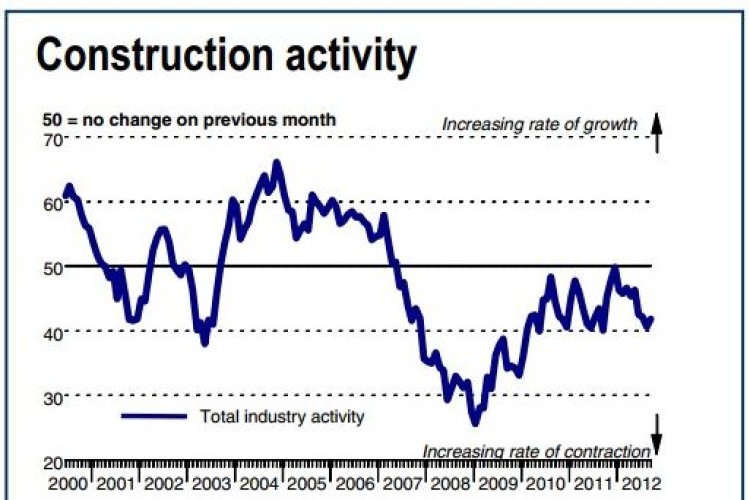By far the steepest reduction in activity was recorded on civil engineering projects. The substantial decline in activity in the sector was the fastest since December 2010. Both housing and commercial activity decreased at slower rates during the month, with the weakest reduction seen for activity on commercial projects.
Falling workloads also led to reductions in employment and purchasing activity. Meanwhile, the rate of input cost inflation quickened to a sharp pace as higher oil and fuel costs led to rising input prices.
The Ulster Bank Construction Purchasing Managers’ Index (PMI) – is a seasonally adjusted index designed to track changes in total construction activity. Figures below 50 signify a fall It registered 41.9 in September, following a reading of 40.7 in August. Although this pointed to a weaker reduction in activity, the pace of decline remained sharp. Panellists mainly linked the latest fall in activity to lower new orders amid weak client confidence.
Commenting on the survey, Simon Barry, chief economist Republic of Ireland at Ulster Bank, said: “As has been the case for well over five years, the Irish construction sector continues to experience declines in activity according to the latest reading of the Ulster Bank Construction Purchasing Managers Index. The survey results for September show that while the pace of contraction eased very slightly last month, the sector continues to exhibit widespread weakness. The overall PMI edged higher from 40.7 in August to 41.9 in September, but at this level remains some distance from the breakeven level of 50 as all three sub-sectors continue to experience substantial declines in activity.”
The rate of contraction did ease a touch in the housing and commercial arenas, but there was a pronounced weakening in civil engineering where activity is now falling at its sharpest pace since the end of 2010.
"In contrast to the persistent declines in construction, last week’s manufacturing and services PMIs both recorded expanding activity levels, highlighting the ongoing divergence in trends between many areas of domestic demand which continue to struggle and the internationally-traded sectors of the economy which are managing to hold up relatively well,” he said. There appears to be little reason to expect this pattern to change much in the near term, with the latest PMIs showing incoming new business levels on the rise in manufacturing and services but still on the slide in construction.”

New orders decreased amid weak client demand and strong competition for any available new business. The pace of reduction eased over the month, but remained substantial.
Declining workloads led to a further reduction in employment in September. The latest fall in staffing levels was sharp, and quickened to the fastest in 16 months.
Input prices rose for the second consecutive month in September. Moreover, the rate of inflation quickened over the month to the sharpest since March. According to respondents, higher oil and fuel costs had been the main reason for the latest increase in input prices.
Lower activity requirements led construction firms to cut their input buying during the month. Purchasing activity has now decreased in each of the past 25 months. Despite falling demand for inputs, vendor lead times continued to lengthen. Panellists indicated that longer delivery times mainly reflected low stock levels at suppliers.
Optimism with regards to the 12-month outlook for activity was signalled in September, and the level of positive sentiment improved slightly over the month. Those firms that forecast an increase in activity linked this to expectations of improving new orders, driven by overseas markets.
Got a story? Email news@theconstructionindex.co.uk



